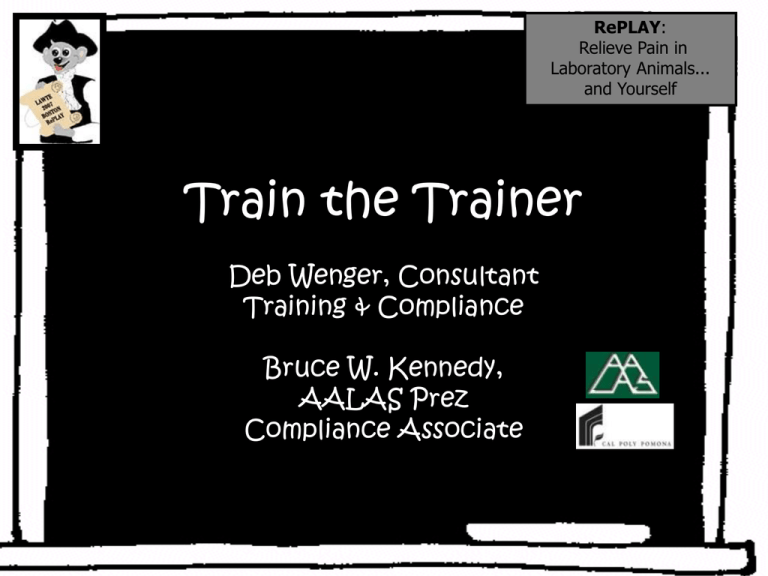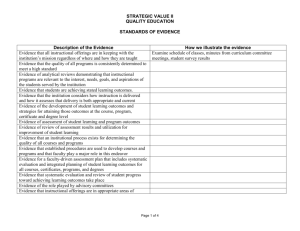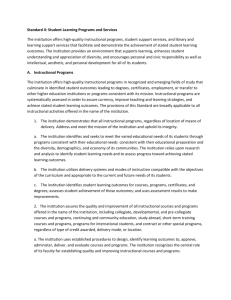Train the Trainer Deb Wenger, Consultant Bruce W. Kennedy, AALAS
advertisement

RePLAY: Relieve Pain in Laboratory Animals... and Yourself Train the Trainer Deb Wenger, Consultant Training & Compliance Bruce W. Kennedy, AALAS Prez Compliance Associate Evolving … TTT – Train the Trainer • started with Sharon Jahn, Tim Lawson, Cindy Pekow, and Helen Diggs; presented at the ‘94 Washington Branch meeting "Tips for Training Trainers and Teaching Technicians" • continued in 1996 with Deb Donohoe an act (action resolution) of the AALAS BOT • for some years, under the auspices of the Educational Resources Committee • several TTT workshops at national, regional/district meetings • Doug Miller took over in 2001/2002 • presented at the Massachusetts Society for Medical Research • presented at ILAM and became “Managing Training” • now with LAWTE Deb Wenger and Linda Fritz at national AALAS Deb W and Bruce at Boston LAWTE meeting (now!!!) First, a little bit of reflection Ron Larson (Hazleton): “Tell ‘em what you’re going to tell ‘em. Then tell ‘em. Then tell ‘em what you just told ‘em.” Many people become trainers because of their knowledge on a particular subject. However, the best trainers are those who realize the ability to train is not something gained from subject knowledge alone, but through an understanding of how to transfer that knowledge to others. This program has been designed to give trainers a comprehensive guide of core knowledge and key competencies expected of trainers. The instructors will take a case study approach to address training in laboratory animal science. Cases involve: developing a curriculum, training various stakeholders, and focusing on the take-home message when everything is important. Participants will be asked to interactively participate in this workshop. Why are you here? ISD Instructional System Design Advantages • Quality instructional material • Focused training, generating better results • Product that streamlines preparation time ISD OBJECTIVES • Identify and define the components of Instructional System Design • Identify and define the components of a training program design • Develop clear and concise learning objectives • Develop a “Training Program Design Document” • Review the process/steps involved in developing the instructional material Misconceptions Regarding Training Assumption #1 A room full of employees with an instructor means something productive, called “training,” is going on. Assumption #2 All it takes to be an effective trainer is knowledge of the technical information being trained. E Analysis V The A L Design U System A T Development I O N Instructional Design Process Implementation E Analysis V A L Design U Development N Observe the task Interview individuals performing the job I O • Needs assessment • Task analysis A T • Foundation for all phases of development Implementation Interview the supervisor Use a task force E Analysis V A L Design U Development I O N • Learning assessment • Delivery system A T • Learning objectives Implementation • Sequencing the instruction E Analysis V A L Design U • Instructional A T Development • Instructional media I O N material Implementation • Documentation E Analysis V A L Design U A T Development I O N Implementation • Delivery of training E The Evaluation Phase measures the effectiveness and efficiency of the instruction. * Formative Evaluations V Analysis A L Design U A T Development I * Summative Evaluations O N Implementation Examples of “Purpose Statements” • “The purpose of the program is to provide procedures, standards and practice in how to design an effective training program.” • “The purpose of this program is to present the proper procedures for the handling and restraint of rats.” • “The purpose of this program is to identify the procedures for handling a complaint involving animal welfare.” Learning Activities: Considerations • • • • • • • Does the activity fit the content? Does it achieve the learning objective? Are resources available? Will learners be able to do it? Are supplies and equipment available? How complex; how long; how challenging? Does it address learning preferences? Factors That Affect Timing • • • • • • • Quality of the Needs Analysis Clarity, focus and type of objectives Design and complexity of the program Technical difficulty and complexity of content Program length Availability of SMEs Skill and experience of the instructional designer Learning Objectives • Clearly define what learners can do after the training is complete • Define the level of skill a learner should perform • Identify conditions and criteria in which the skill must be performed Principles of Instructional Design • • • • • • Appropriate Motivational Two-way communication Feedback Learner types Exercise Development Process • • • • Phase I: Phase II: Phase III: Phase IV: Instructor’s Manual Participant’s Manual Media Learning Activities/ Handouts Instructor’s Manual Introductory Materials Title Page Table of Contents Overview of Program Time and Event Outline Equipment, Materials, and Room Setup Instructional Materials Introduction Administrative Details Purpose of Program Learning Objectives Presentation Summary Appendix Copies of Handouts Copies of Media Glossary of Terms Bibliography Participant’s Manual Introductory Title Page Table of Contents Overview of Program Materials Program Content Learning Objectives Modules Learning Assessment Appendix Copies of Media Glossary of Terms Bibliography the 6 Ws another approach to ISD a group exercise • • • • • • Why Who What Where When hoW Case study communication • snowflake exercise • • • • SOPs teaching style ESL the language of science ? • session: “Enhancing Cross-Cultural Communication In Training,” Dr. Genevieve Fridland, AALAS hoW Three Channels of Delivery • delivery skills vocal – verbal, vocal, visual verbal • communication visual – snowflake exercise to demonstrate style differences in delivery Three Channels of Delivery • presentation pointers Factor Description Amount verbal using words that engage both parties 7% vocal presence of voice quality and signals 38% visual behavior and overall presence 55% – examples from you Case study vocabulary • • • • difficulty with science jargon useful for ESL, too taught thru a game crossword puzzles – software to build your own – using the TechTalk puzzle What ‘good’ things can you tell from this slide? 1. a litter has been born 2. milk spot is present 3. mom is maternal 4. anything else? What procedure is being done? (3 similar terms) • tail cutting • tail tipping • tissue biopsy When should it be done? Why then? • before 4 to 5 weeks of age • the bone of the tail calcifies and it hurts more to cut it. What is done with the sample? • it is genotyped; the analysis of the DNA for a particular hoW crossword puzzle of lab animal science acronyms www.varietygames.com Case study teaching dry stuff that is critical • teaching facts (typically dry stuff) vs. technical (perhaps more interesting) • worksheets • what do they absolutely have to know?! • it’s all critical, isn’t it? – good to know, have to know, fun to know • quiz format – if they pass a quiz with the content you want them to know, why trouble them with training? Case study using humor and cartoons outreach transgenics PI breeding ethics/PR Q: What do you call a test tube with training and a college degree? lab A: a ‘graduated’ cylinder Case study euthanasia, Karoline Machado, Ontario • how do you teach someone • … to become skilled at a technique • several workshops/sessions or just one? • it seems we focus on rodents Case study training time, Steve Durkee, Michigan • mandatory classes? • lecture, hands-on? • how many to be trained? – total staff – new employees, orientation • devoted training staff? – to support researchers – to support husbandry • negotiating schedules • when to train? – the plusses and minuses • on-line 24/7 Case study where do you get your materials • Norina website, with several videos, is an excellent resource. http://oslovet.veths.no/ • LAWTE, of course Case study learning styles • someone just isn’t “getting it” • do we learn the same way? • do adults learn like children? – andragogy vs. pedagogy • do we teach/train the way we want to learn? 1 4 16 2 18 3 34 32 Effective learning approaches based on personality style feeler checklists charts hands-on examples field trips how-to discussions analyzer lectures reading writing reports panel discussions forming hypotheses working alone observer team games cooperative groups visual thinkers role players idea sharing group discussions organizer experimenting active learning brainstorming finding alternatives doing case studies learning games Case study training records, Emi Yano, Toronto • certificates, electronic or hard copy • database software – UBC (Daniel Harvey): Excel, Adobe LiveCycle (on-line sign-ups) – Cal Poly Pomona: Microsoft Access, dotnet, protocol linked to EH&S and training databases – AALAS ALL (Nicole Duffee and Pam Grabeel) • session: “AAALAC Expectations for Animal Care Training Programs,” Dr. Jim Swearengen, AAALAC, Int. Training documentation • • • • CEUs AALAS certification and registry other licensors and credentials certificate of participation awarded to I. M. Anitecher Case study training records 1. It seems to be the standard at institutions to issue certificates upon course completion. We also issue paper certificates. Would an e-copy suffice? We could cut back on the cost of training that way. Have you found that copies of these certificates come in handy as proof of training? I am trying to keep my records electronically but don't want to scrap the certificates if they are useful. I have hard copies of all the training, but do not give out any certificates. I print-out a hard copy of all of the procedures the person is signed off to perform. At UBC we have lots of international students and they like having a certificate to show to their future employers. I find that having a hard copy at my desk is useful to have in case the computer does not work properly at the time of a site visit. we issue certificates of completion for longer training programs (1/2 day programs or multi-day programs). The certificates are more for the individuals to keep track of their own training. Session signin lists are typically used to document in-house training for our paper-based record keeping system. When individuals attend outside training programs (e.g. the LAWTE meeting coming up in August), we do ask that they make a copy of that certificate for their training record. This also holds true for completion certificates for online courses through the AALAS Learning Library. 2. What software do you use to track and update training? Do you use on-line sign-ups? E-mail reminders? Any recommendations? Unfortunately we don’t have a software just as of yet and I am still using an Excel spreadsheet but I make sure to include the year of completion somewhere in the certificate number so it will be easier to call back those people for the refresher courses. I am working on on-line sigh up forms with Adobe LiveCycle . I do use e-mail reminder a week prior to the course/workshop. I use Access. I created a database to keep track of all of the training. I also use e-mail to remind people when re-training is due (every 3 years). We still use a paper-based training record system....but will be transitioning to a Learning Management System. Tracking and updating training is currently done by HR. They maintain, on paper, a roster of who has been trained in what and will notify the designated trainers of those individuals needing training in specific areas (e.g. zoonotic diseases) on a regular schedule (e.g. twice a year for zoonotic disease training). We do use online sign-ups through Outlook, although this is not a necessity. Through Outlook, we are able to utilize e-mail reminders. Case study who is the trainer? • who is doing the training – manager, supervisor • issues with employee performance – – – – – designated trainer PIs veterinary staff vendors computers Case study stakeholders in training • who is being trained – – – – – typical lab animal personnel PIs IACUC members (outside member, too?) facility personnel, including contractors human resources Case study the basics of a training session • what have we learned today? • as taught thru a game • using a version of Jeopardy RePLAY: Relieve Pain in Laboratory Animals... and Yourself Train the Trainer Thank you for your participation! Deb and Bruce





